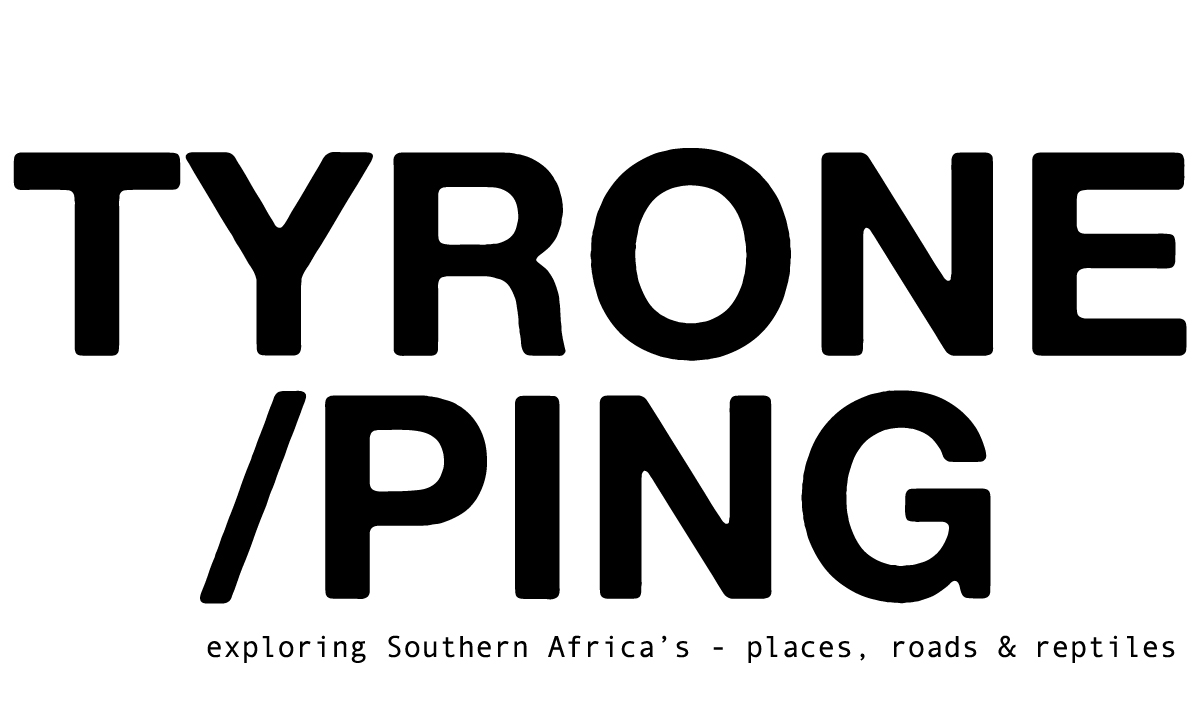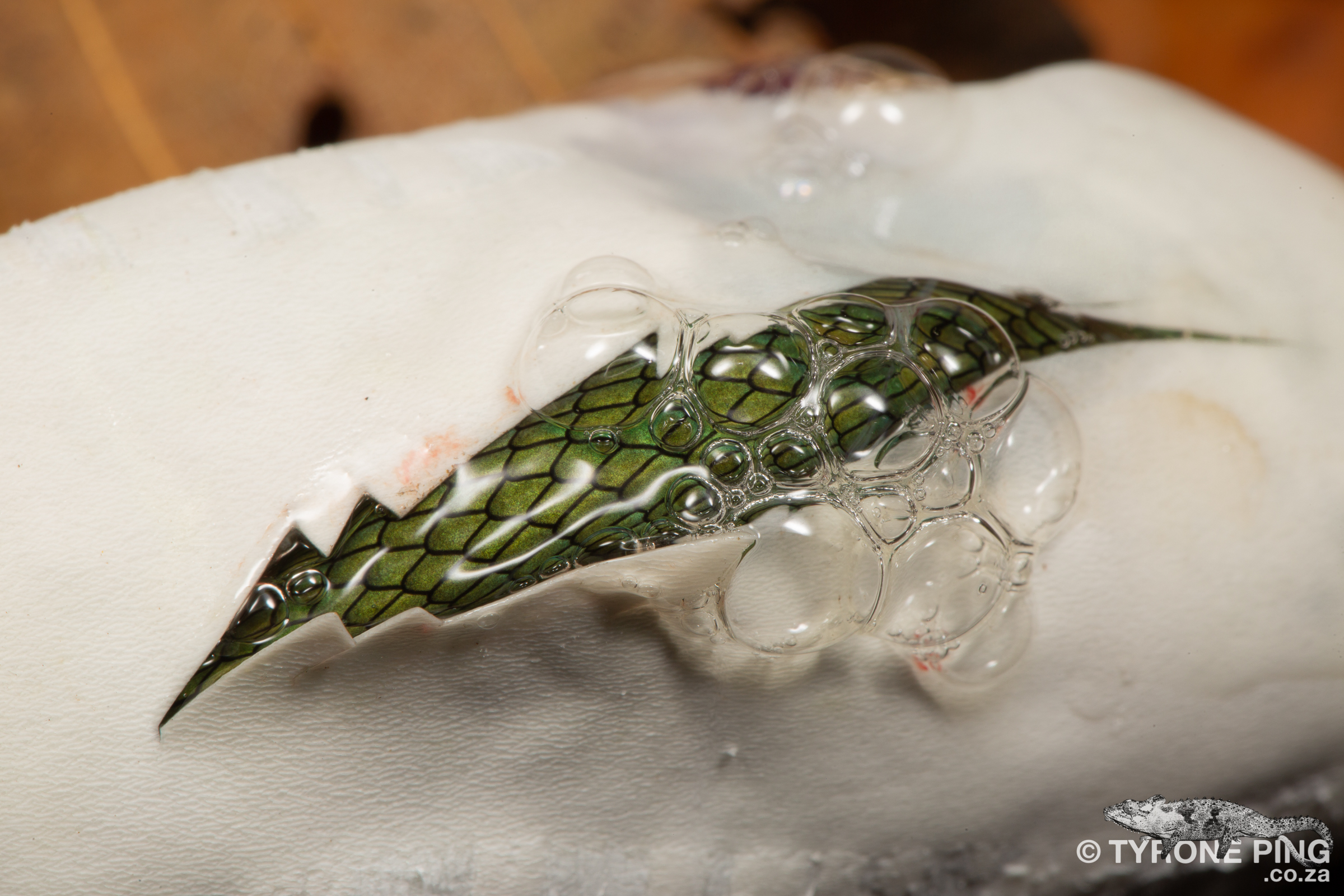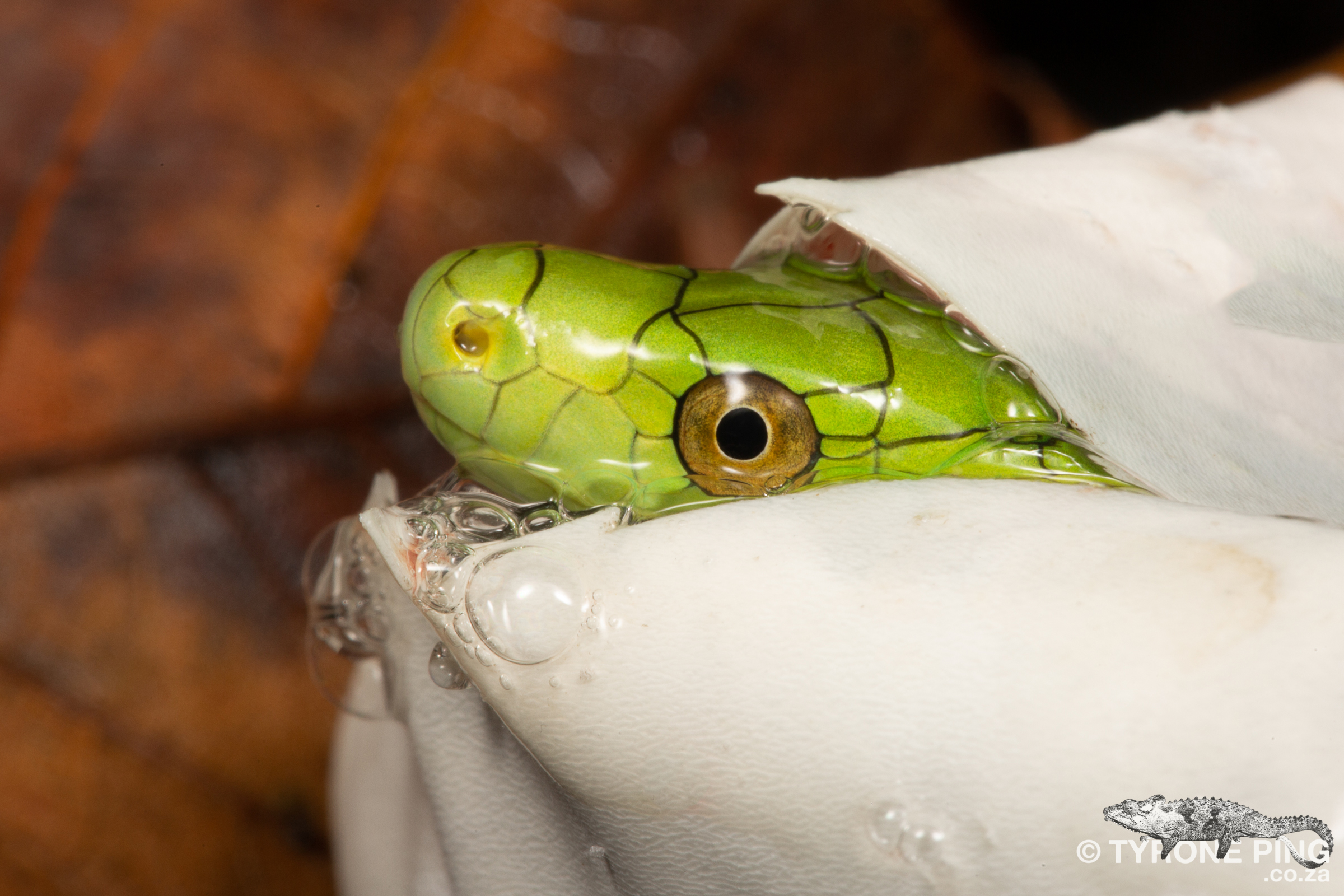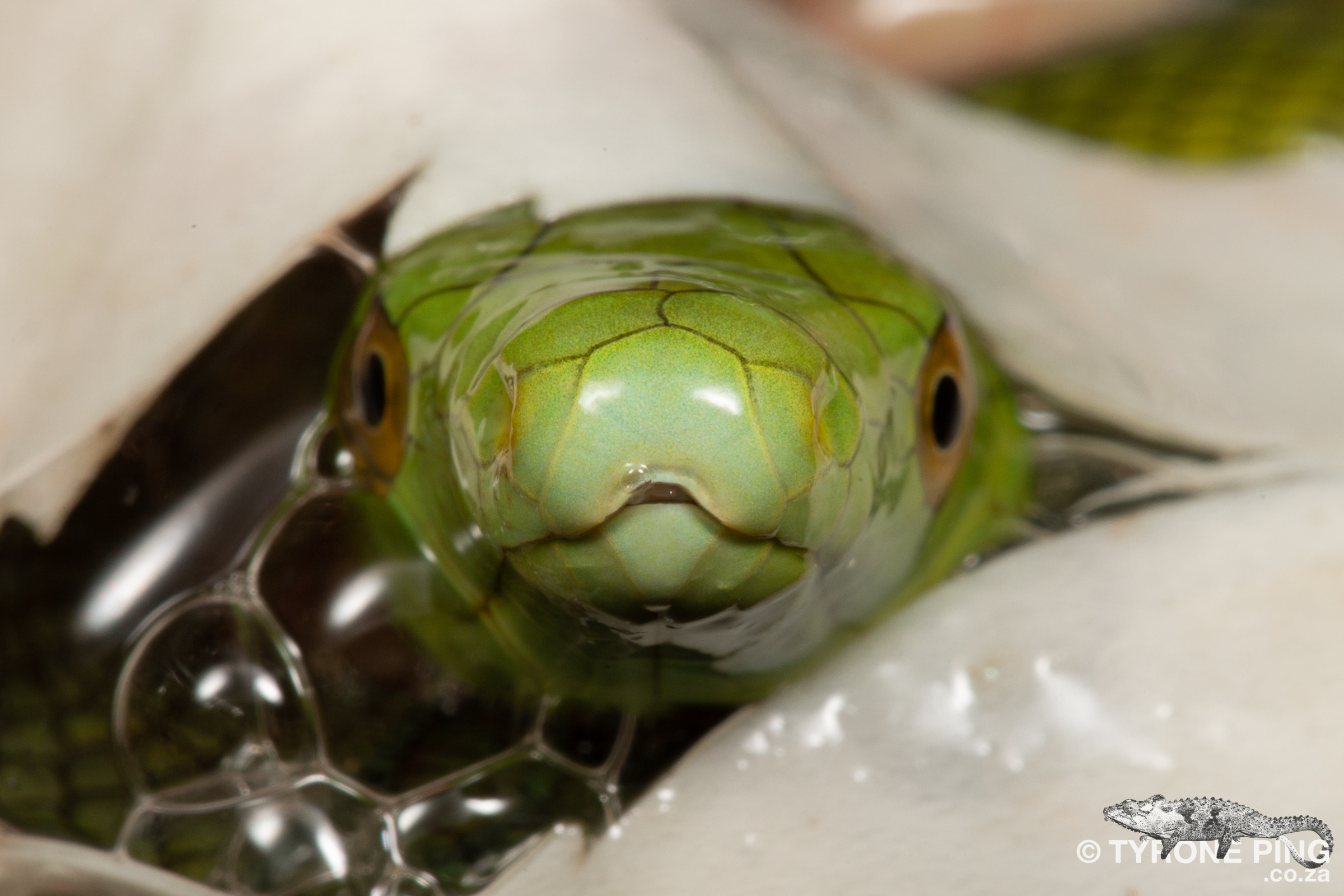Eastern Green Mamba (Dendroaspis angusticeps) Hatching In Photos
Snakes may not be everyone’s idea of cute and cuddly animals and the truth is you should never cuddle a potentially venomous snake anyway. But you cannot help but marvel at the fascinating way these animals lay their eggs, abandon them and somehow the eggs survive the elements ,avoid being eaten by predators like mongoose and monitor lizards.
Towards the end of November 2019 a concerned member of staff at a housing and golf estate in Pennington on the South Coast of Kwa-Zulu Natal called. This beautiful setting nestled amongst the lush green indigenous coastal forest and wild bananas plants is a haven for snakes and unfortunately when people choose to live, work and play in these areas people and snake interactions are bound to happen and interactions can usually go one of three ways:
1 – The snake is seen and left alone and eventually disappears to continue on its way and likely not seen again.
2 – The snake is killed without incident and following which the person may try look up or ask across social media what snake it was – much too many snake lovers despair.
3 – Now this is a far more serious and often avoidable situation, the snake is seen and in panic mode attempted to be killed or handled which result in a snake bite – never a good thing in any circumstance.
Fortunately in this case the caring caller made the best choice and called myself or could have been any qualified snake remove to rather relocate the snake than having it killed.
After a short drive down the South Coast arriving where the snake was seen and without incident and with a small crowd of onlookers the snake was securely removed and the gorgeous 1.35m Eastern Green Mamba into a clear bucket for transportation to remove it offsite into some nearby vegetation (away from the golf estate). The snake had made its way onto the course and naturally golfers enjoying their Friday afternoon 18 holes had little time or patience for this highly venomous snake to move off on its own.
Shortly after taking the snake out pre-release and taking a few photographs it was apparent snake looked extremely heavy towards the lower 2/3rds of the body – while restraining the animal safely in perspex tubes I gentle felt the underside and yes – she was gravid (carrying a clutch of eggs essentially pregnant). Now to release an animal in a slightly unfamiliar environment (although less than 5km from the location she was caught) is irresponsible when the snake is this close to laying eggs as if the snake is unable to find a suitable nesting site she may retain the eggs internally causing severe complications resulting to the loss of the eggs and in some instances death of the snake. So packing the sane back safely i returned home with the snake setting her up in a large enclosure with a nesting box (a dark area with moist substrate suitable for egg laying). Not 36 hours later she had laid 7 perfectly formed eggs which are around 5-6cm long and 2.5cm wide. The eggs were then placed in a specialised incubator and incubated at 28.5 degrees.
After two and a half months of checking in daily, opening and checking humidity levels on day 70 the first signs of movement inside the eggs started to happen, the eggs began to sink in slightly and become soft to the touch. It was not until day 73 when the first slit in the eggs appeared! Now hatching of snake eggs can take place in a matter of hours or over several days. Day 73 two babies hatched, Day 74 two, Day 75 three and only day 76 the final hatchling decided to emerge from the egg.
The snakes were all housed separately in sterile enclosures and after around 7 days begin to shed their skins for the first time, all 7 hatchlings measure 35-40cm and are perfect replicas of the adults and ready to fend for themselves from the moment they leave the egg.
All 7 young snakes were released in the exact same stretch of bush where the female snake was found just away from the golfers and their greens. These snakes were lucky, If it was not for the one call essentially 8 Eastern Green Mambas would not be back in the wild today. They’ve been given a kick start, now they will have to avoid the busy roads that dissect this natural paradise, predatory birds, mongoose, even other snakes like the Mozambique Spitting Cobra and of course let’s not forget the most dangerous of them all the unaware human who don’t understand the vital role that snakes play in our shared sensitive ecosystem.
Here is a sequence of one of the snakes starting to hatch and cutting through the egg.
The indication that something is stirring within the egg and the young snake is ready to leave the egg. Notice the small incisions made by the snake within the egg using the specialised egg tooth.
Tentatively the hatchling sticks out its nose to get a sense of its surroundings. A A head on shot where the egg tooth is barely visible on the upper jaw on the snout.
The hatchling Eastern Green Mamba flicks out its tongue for the very first time and “tastes” the new world to get familiar with the new surroundings.
Finally with the whole head out – ready to face the world.
Facts About Snake Eggs and Hatchling Snakes:
Do all snakes lay eggs?
Not all snakes lay eggs, some snakes live birth to live young.
Oviparous refers to when snakes lay eggs and viviparous refers to when snakes give birth to live young. In South Africa these include: Mole Snakes , Slug Eaters, Rinkhals and all Adders.
What are the bubbles and clear fluid in the egg, and is it dangerous?
This is simple the fluid that the eggs are suspended in during their development.
Are snake eggs like bird eggs?
Snake eggs are not hard like bird eggs but soft and leathery, the eggs expand as the eggs grow.
What affects snake eggs?
Without the optimal humidity snake eggs will dry out and should the egg roll or is inverted the embryo will die.
How long do snake eggs take to hatch?
Depending on the species snake eggs can take as little as 45 days some can take well over 100 days depending on temperature.
How do snakes get out of their Eggs?
Snakes use a specialised “egg tooth” which is minute, to slice through the egg which falls off soon after hatching as it serves no use.
Are baby snakes as venomous as the adults?
Venomous snakes are as venomous as the adults the moment they emerge from the egg and have the ability to kill prey from the outset. They simply have a smaller yield although in many species even a minuscule amount of venom is capable of killing a person.
When do baby snakes shed their skin?
Many newly hatched snakes will shed their skins after a week or so then begin to start their quest for their first meal.
How soon after the eggs hatch do the baby snakes eat?
Most hatchlings can go without food for around 2 weeks as they’re still sustained from the yolk of the egg.
Do snakes look after their babies?
With the exception of the Southern African Python and Spotted Grass Snake (Spotted Skaapsteker) snakes offer no maternal or paternal care. The Southern African Python will coil around the eggs until they hatch and remain with the hatchlings for a few days until the mother moves off. The Spotted Grass Snake (Spotted Skaapsteker) coils around the eggs until they start to hatch and will move off and the young are on their own.








Tyrone Ping – wonderful photography and such amazing information.
Colin Jennings
Cheers Colin – glad you enjoyed them!